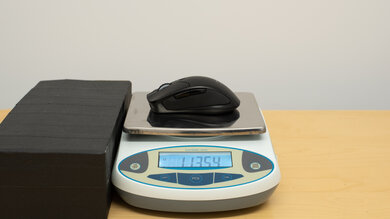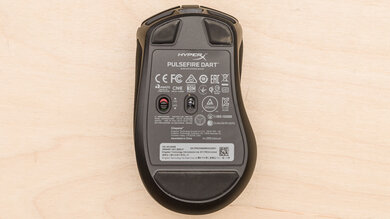The HyperX Pulsefire Dart is a decent wireless gaming mouse that feels well-built and has cushioned side grips. It's well-suited for all grip types and very nearly all hand sizes; however, small hands may not reach the scroll wheel using a fingertip grip, and extra-large hands may drape over the front using a palm grip. It has a wide CPI range, a CPI you can adjust by increments of 50, a low lift-off distance, and good click latency, and it connects wired or wirelessly with its USB receiver. It also comes with a wireless extender and is Qi-Certified for wireless charging, but we don't test for this, and a wireless charging device isn't included. Unfortunately, it lacks Bluetooth support, its software is only compatible with Windows, and there's no storage compartment for its USB receiver.
Our Verdict
The HyperX Pulsefire Dart is good for office and multimedia work. It feels well built, and it connects wired or wirelessly with a USB receiver. It has a good number of buttons you can program using the companion software, though it's only compatible with Windows. That said, it also has onboard memory that allows you to use your custom settings on computers without the software installed. Unfortunately, this mouse doesn't support Bluetooth, and its scroll wheel lacks L/R tilt buttons and has no free-scrolling mode.
-
Feels well-built.
-
Good number of programmable buttons.
-
Ergonomic shape suitable for all grip types and nearly all hand sizes.
-
Onboard memory.
-
No Bluetooth support.
-
No internal storage for USB receiver.
The HyperX Pulsefire Dart is a decent FPS gaming mouse that feels well built and has a comfortable, right-handed shape suitable for all grip types and nearly all hand sizes. Performance-wise, it has a wide CPI range, a CPI you can adjust by increments of 50, low click latency, and a low lift-off distance, though it's not as low as some other options. Unfortunately, it's heavy, and some FPS players may prefer a more lightweight mouse.
-
Feels well-built.
-
Ergonomic shape suitable for all grip types and nearly all hand sizes.
-
Good click latency.
-
Heavy.
-
Mouse feet are only decent.
The HyperX Pulsefire Dart wireless is decent for MMO gaming, but it doesn't have nearly as many side buttons as a dedicated MMO mouse. Nevertheless, it feels well-built and has a right-handed shape suitable for all grip types and almost all hand sizes. Performance-wise, it has a wide CPI range, a CPI you can adjust by increments of 50, and low click latency. It also has a low lift-off distance. However, it's not as low as some other gaming mice.
-
Feels well-built.
-
Ergonomic shape suitable for all grip types and nearly all hand sizes.
-
Not nearly as many side buttons as a dedicated MMO mouse.
The HyperX Pulsefire Dart is too heavy to be considered an ultra-light gaming mouse. Nevertheless, it feels well-built with a comfortable shape suitable for all grip types and nearly all hand sizes. It also has good click latency, though its mouse feet are only decent and make a scratching sound when used directly on desks.
-
Feels well-built.
-
Good click latency.
-
Heavy.
-
Mouse feet are only decent.
The HyperX Pulsefire Dart is okay for travel, but it's bulky and may not fit in some laptop cases. That said, it feels well-built and connects wirelessly with its USB receiver. It also has onboard memory for using custom settings on computers without the software installed. Unfortunately, it doesn't support Bluetooth, and there's no storage compartment for its USB receiver when not in use.
-
Feels well-built.
-
Onboard memory.
-
No Bluetooth support.
-
No internal storage for USB receiver.
- 7.9 Office/Multimedia
- 7.5 Video Games (FPS)
- 7.1 Video Games (MMO)
- 6.7 Ultra-Light Gaming
- 6.8 Travel
Changelog
- Updated Sep 28, 2022: We've converted this review to Test Bench 1.2. This update simplifies our Weight test and expands on our CPI test from Test Bench 1.1, resulting in changes to test results in both sections. For more details, you can see our complete changelog here.
- Updated Sep 21, 2022: We've converted this review to Test Bench 1.1. This update revamps our Click Latency test and results in changes to test results. For more details, you can see our full changelog here.
- Updated Jul 14, 2021: Review published.
- Updated Jun 29, 2021: Early access published.
- Updated May 21, 2021: Our testers have started testing this product.
Check Price
Differences Between Sizes And Variants
The HyperX Pulsefire Dart wireless gaming mouse we tested is black, and there aren't any other color variants. You can see the label for our unit here.
Compared To Other Mice
The HyperX Pulsefire Dart is a decent wireless gaming mouse and the only current wireless model in the new HyperX Pulsefire lineup. Like most of the mice in the lineup, it uses the mid-range Pixart 3389 sensor, which offers better performance than the Pixart 3327 in the budget HyperX Pulsefire Core, but not quite as good as the Pixart 3335 in the HyperX Pulsefire Haste. As the only wireless model, it's the only mouse in the lineup that's Qi-Certified for wireless charging. However, it doesn't include a wireless charging device. Unfortunately, it's heavy, even for a wireless gaming mouse, and there are numerous more feature-rich options available in the same weight range.
For more recommendations, check out our picks for the best mice, the best gaming mice, and the best wireless gaming mice.
The Razer Viper Mini is an excellent ultra-light gaming mouse, while the HyperX Pulsefire Dart is a decent wireless gaming mouse. The Razer is a wired-only mouse that's significantly lighter and feels better built. It also has mouse feet that glide much more smoothly and significantly lower click latency. You can also assign a G-Shift button using the companion software to enable a secondary layer of commands. On the other hand, the HyperX connects wirelessly with its USB receiver and has a wider CPI range and a more precisely adjustable CPI.
The Logitech MX Master 3 is an excellent wireless mouse designed for office use, while the HyperX Pulsefire Dart is a decent wireless gaming mouse. The HyperX is lighter and has better performance for gaming, including a wider CPI range, a much higher maximum polling rate, and a bit lower click latency when connected with its wireless receiver. On the other hand, the Logitech is oriented towards comfort and productivity. It has a thumb rest with a gesture button, a thumb wheel, and a primary scroll wheel with L/R tilt buttons, and a free-scrolling mode. It also supports Bluetooth and has customization software compatible with Windows and macOS.
The GLORIOUS Model D is an excellent ultra-light gaming mouse, while the HyperX Pulsefire Dart is a decent wireless gaming mouse. The GLORIOUS is much lighter but is a wired-only mouse. It has a much more flexible cable and mouse feet that glide more smoothly. It also has significantly lower click latency. On the other hand, the HyperX feels better built and connects wired or wirelessly with its USB receiver. It also has a wider CPI range, a more precisely adjustable CPI, and Qi-Certified wireless charging. Both mice are suitable for all grip types and most hand sizes.
The Logitech G703 LIGHTSPEED with HERO Sensor is a better wireless gaming mouse than the HyperX Pulsefire Dart. The Logitech is lighter and feels sturdier. It also has a more flexible charging cable, a wider CPI range, a more consistent sensor, a lower lift-off distance, and much lower click latency. It also has software compatible with Windows and macOS, while the HyperX only has software compatible with Windows. Both mice are suitable for all grip types and most hand sizes.
The Razer Basilisk Ultimate is a better wireless gaming mouse than the HyperX Pulsefire Dart. It's slightly larger, but it's lighter and has a thumb rest. It also has a more flexible charging cable, mouse feet that glide more smoothly, a wider CPI range, a lower lift-off distance, and significantly lower click latency. It has one additional side button, more programmable inputs, and a scroll wheel with L/R tilt buttons and free scrolling. The Razer also has a storage compartment for its USB receiver when it's not in use, which the HyperX lacks. Comparatively, the HyperX supports Qi-Standard wireless charging.
The Logitech G PRO X SUPERLIGHT is a better wireless gaming mouse than the HyperX Pulsefire Dart. It's much lighter and feels sturdier. It also has mouse feet that glide smoother, a wider CPI range, a more precisely adjustable CPI, a lower lift-off distance, and significantly lower click latency. Additionally, it has a storage compartment for its USB receiver, while the HyperX doesn't. And its software is compatible with Windows and macOS, while the HyperX software is only compatible with Windows. On the other hand, the HyperX has a USB-C standard charging cable rather than the older micro-USB charging cable used by the Logitech.
The HyperX Pulsefire Dart and the Microsoft Sculpt Ergonomic Mouse are mice designed for different uses. The HyperX is better suited as a wireless gaming mouse, while the Microsoft is a wireless mouse suited for office or productivity tasks. The Microsoft has an ergonomic design, a scroll wheel with L/R tilts for horizontal scrolling, and a storage compartment for its USB receiver, which the HyperX lacks. On the other hand, the HyperX has many more customization features for its sensor. However, both mice lack Bluetooth compatibility, and neither have software available on macOS.
Test Results
If you'd like a modular mouse that you can use left-handed, check out the DELUX M627.
The HyperX Pulsefire Dart wireless gaming mouse includes a cable for recharging, but it's also Qi-certified and supports wireless charging using any Qi-standard device. However, this isn't something we test.
The polling rate options on the HyperX Dart are 125Hz, 250Hz, 500Hz, and 1000Hz. For a similar mouse with a lower lift-off distance, check out the ASUS ROG Gladius III Wireless.
Comments
HyperX Pulsefire Dart: Main Discussion
Let us know why you want us to review the product here, or encourage others to vote for this product.

































